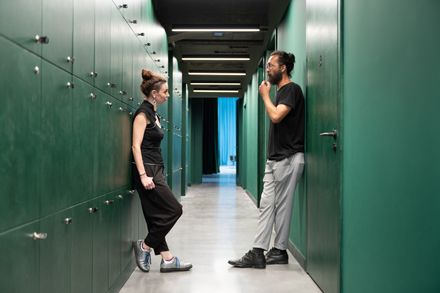
Atelier Gardens Studio 1
WATER MANAGEMENT
Hati Gesellschaft Für Handwerk Technik Und Innovation
PROJECT COORDINATION ATELIER GARDENS
Drees & Sommer
AV CONSULTANTS
Mmt Network
FOUNDING PARTNER IN CHARGE
Jacob Van Rijs
CO ARCHITECT ATELIER GARDENS
Hs-architekten
CURTAIN RAIL MANUFACTURER
Mkt Engineering Gmbh & Co
FIRE PROTECTION CONSULTANTS
Brandschutz Plus+eberl-pacan Brandschutzplaner
DEVELOPER AND INVESTOR
Fabrix
GENERAL CONTRACTOR
Kpm3
LANDSCAPE DESIGN
Harris Bugg Studio
STRUCTURAL ENGINEERING
B+g Ingenieure Bollinger Und Grohmann
DIRECTOR
Enno Zuidema
ENVIRONMENTAL ADVISOR
Peter Mensinga
DESIGN TEAM
Klaas Hofman, Jonathan Schuster, Monica Di Salvo, Pim Bangert, Brygida Zawadzka, Daniella Persson, Chiara Tomassi, Andre Bahremand, Simone Costa, Egle Jacinaviciute, Emilie Koch, Alexandra Farmazon, Stijn Lanters, Mathias Pudelko, Alexandru Mitea
VISUALIZATION
Antonio Luca Coco, Pavlos Ventouris, Angelo La Delfa, Luca Piattelli, Francesco Vitale, Jaroslaw Jeda, Luana La Martina, Lorenzo D’alessandro, Gianlorenzo Petrini, Stefania Trozzi
PHOTOGRAPHS
Yasutaka Kojima, Stefan Korte
AREA
23800 m²
YEAR
2022
LOCATION
Berlin, Germany
CATEGORY
Mixed Use Architecture, Offices Interiors, Cowork Interiors
Text description provided by architect.
Situated on the southern edge of Berlin’s Tempelhof Airport, BUFA has been a key part of Berlin’s film and television industry since its first buildings were constructed over a century ago.
Now, BUFA is expanding its user base beyond filmmakers to encompass all forms of ‘change makers’, including organisations and individuals with a focus on activism and social justice – catalysed by a change of identity in its physical spaces.
The five filming studios and assortment of ancillary facilities form a dense campus: large, charismatic brick buildings define narrow alleys and open plazas.
MVRDV’s design preserves and enhances this spatial diversity: a series of sustainable transformations, which take advantage of the existing structures rather than demolishing and rebuilding, refresh the buildings while maximising the potential of the spaces between.
The campus will be transformed with an ecologically focused landscape: large areas of paving are removed, eliminating vehicles and adding water permeability and biodiversity with rooftop gardens and green plazas.
Other sustainability measures are also incorporated, such as eco-toilets, rainwater collection and water recycling, and improved natural ventilation. Another proposal currently under consideration would see steel salvaged from the demolition of two outdated warehouses reused directly on site to create a new entrance pavilion.
The masterplan for the 23,800m2 campus takes an incremental approach to refresh the film studios, considering each building transformation as a response to the previous ones.
The first of these developments, which have recently received construction approval, are the transformation of the building next to the main entrance known as House 1, and the renovation of Studio 1.
At almost 100 years old, Studio 1 is somewhat outdated for modern film production, being used most in recent years for television productions and commercials.
It is also a listed building, which necessitated a design that creates a flexible space for a variety of uses without permanently altering the existing features of the building in any significant way.
The rail supports a variety of curtains in a range of bright colours, from raspberry to honey yellow, that can be used to divide the space, each with different functions (such as acoustic curtains and translucent curtains).
The design needed to lengthen the lifespan of the building to ensure a sustainable future for the campus while also respecting its history.
MVRDV’s design achieves this through a “low tech transformation” with one stand-out feature: an intricate overhead curtain rail that – unlike in most film studios where curtain rails are hidden – becomes a focal point of the space.
In this way, the new additions contrast the original building: flexible instead of fixed, and colourful instead of black. Brick walls are kept visible, while above the curtain rail, a skylight is added in the roof of the building to make the space more suitable for different uses.
Other features of the building are updated, with new interior surfaces and a new more efficient ventilation system. The transformation of House 1, which was originally built in 1997, is more radical. The building has a poor indoor climate, with overheating in summer and poorly insulated walls.
It is made moreefficient by a green “wrap”, created with a wooden frame and climbing plants, delivering maximum impact with minimal material. This frame extends above the roofline to form a sheltered garden and rooftop pavilion, accessible from both the building itself and a zig-zagging staircase that leads directly to the rooftop.
Inside, the building will host flexible workspaces, a café-bar, and meeting spaces, with a similar goal of achieving maximum performance improvement with minimal new material.

















